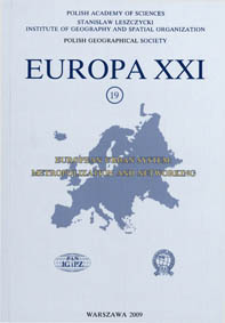
Obiekt
Tytuł: “Shrinking city” – term to be verified?
Inny tytuł:
Wydawca:
Miejsce wydania:
Opis:
Każdy numer posiada własny tytuł. ; 29 cm
Typ obiektu:
Abstrakt:
City crisis has been a subject of urban debates in both Anglo-Saxon and German space. “Shrinking city” (schrumpfende Stadt) term was developed in Germany and means a persistent urban crisis which is characterized by depopulation and worsening economic conditions. Nowadays, often, the only determinant for calling a city as shrinking is a population decrease. Such understanding might be misleading. In the Author’s view age structure of population is at least as important for the city economic performance and physical development as its quantitative change.
Bibliografia:
1. Beauregard, R. A. (1993), Voices of decline. The postwar fate of US cities, Blackwell, Cambridge.
2. DGIPU, (2007, November 11), Shrinking regions: a paradigm shift in demography and territorial development. Retrieved April 12, 2009, from <http://www.europarl.europa.eu/meetdocs/2004_2009/documents/dv/pe408928_ex_/pe408928_ex_en.pdf>
3. Eisenmenger, M., Pötzsch, O. and Sommer, B. (2006), 11. koordinierte Bevölkerungsvorausberechnung—Annahmen und Ergebnisse. Retrieved December 05, 2008, from <www.destatis.de>
4. Gatzweiler, H.-P. and Strubelt, W. (1988), Demographische Veränderungen und Wandel in der Städte, Soziologische Stadtforschung,Vol. Sonderheft, 29, 193–221.
5. Glaeser, E. L. and Gottlieb, J. D. (2006), Urban Resurgence and the Consumer City, Urban Studies, 43 (8), 1275–1299.
http://dx.doi.org/10.1080/00420980600775683 -
6. Glock, B. (2006), Stadtpolitik in schrumpfenden Städten. Duisburg und Leipzig im Vergleich, Verlag für Sozialwissenschaften, Wiesbaden.
http://dx.doi.org/10.1007/978-3-531-90452-8 -
7, Grossmann, K. (2007), Am Ende des Wachstumsparadigmas? Zum Wandel von Deutungsmustern in der Stadtentwicklung. Der Fall Chemnitz, transcript Verlag, Bielefeld.
http://dx.doi.org/10.14361/9783839407189 -
8. GUS, (1977), NRD—Polska wybrane dane porównawcze, Departament Statystyki Międzynarodowej, GUS, Warszawa.
9. Haller, C. (2004), Plädoyer für klare Begrifflichkeiten im Stadtumbauprozess. Retrieved December 15, 2008, from <http://www.schrumpfende-stadt.de/magazin/0401/8haller.htm>
10. Hannemann, C. (2004), Marginalisierte Städte—Probleme, Differenzierungen und Chancen ostdeutscher Kleinstädte im Schrumpfungsprozess, Berliner WissenschaftsVerlag, Berlin.
11. Häußermann, H. and Siebel, W. (1988), Die schrumpfende Stadt und Stadtsoziologie, Soziologische Stadtforschung, Vol. Sonderheft, 29, 78–94.
12. Häußermann, H. and Siebel, W. (1987), Neue Urbanität, Suhrkamp, Frankfurt am Main.
13. Kaufmann, F.-X. (2005), Schrumpfende Gesellschaft, Suhrkamp, Frankfurt am Main.
14. Mykhenko, V. and Turok, I. (2007), Shrinking cities: East European Trajectories 1960–2005, Centre for Public Policy for Regions Glasgow.
15. Oswalt, P. and Rieniets, T. (eds.) (2006), Atlas of Shrinking Cities; Atlas der schrumpfenden Städte, Hatje Cantz Verlag.
16. Pfeiffer, U. (2005), Subsidy culture. Shrinking Cities, (Vol. 1), International Research, 670–677. (P. Oswalt and U. Steglich Interviewers), Hatje Cantz Verlag.1
17. Pfeiffer, U., Simons, H. and Porsch, L. (2000), Wohnungswirtschaftlicher Strukturwandel in den neuen Bundesländern, Bericht der Kommission, Fraunhofer IRB Verlag.
18. Sassen, S. (2006, July 3–10), How Population Lies, Newsweek International.
19. <www.regionalstatistik.de>
20. <www.stat.gov.pl>
Czasopismo/Seria/cykl:
Tom:
Strona pocz.:
Strona końc.:
Szczegółowy typ zasobu:
Format:
Rozmiar pliku 0,5 MB ; application/pdf
Identyfikator zasobu:
oai:rcin.org.pl:55819 ; 1429-7132 ; 10.7163/Eu21.2008.19.4
Źródło:
CBGiOŚ. IGiPZ PAN, sygn.: Cz.6406, Cz.6407 ; kliknij tutaj, żeby przejść
Język:
Prawa:
Prawa zastrzeżone - dostęp nieograniczony
Zasady wykorzystania:
Digitalizacja:
Instytut Geografii i Przestrzennego Zagospodarowania Polskiej Akademii Nauk
Lokalizacja oryginału:
Dofinansowane ze środków:
Unia Europejska. Europejski Fundusz Rozwoju Regionalnego ; Program Operacyjny Innowacyjna Gospodarka, lata 2010-2014, Priorytet 2. Infrastruktura strefy B + R
Dostęp:
Kolekcje, do których przypisany jest obiekt:
- Instytut Geografii i Przestrzennego Zagospodarowania PAN > Publikacje pracowników i Wydawnictw
- Instytut Geografii i Przestrzennego Zagospodarowania PAN > Biblioteka Instytutu > Serie/Czasopisma/Cykle
Data ostatniej modyfikacji:
25 mar 2021
Data dodania obiektu:
14 sie 2015
Liczba pobrań / odtworzeń:
1109
Wszystkie dostępne wersje tego obiektu:
https://www.rcin.org.pl/igipz/publication/75504
Wyświetl opis w formacie RDF:
Wyświetl opis w formacie RDFa:
Wyświetl opis w formacie OAI-PMH:
| Nazwa wydania | Data |
|---|---|
| Cieśla A. - “Shrinking city” – term to be verified? | 25 mar 2021 |
Obiekty Podobne
Wiśniewski, Rafał Szejgiec-Kolenda, Barbara Śleszyński, Przemysław
Krzysztofik, Robert Szmytkie, Robert
Brito-Henriques, Eduardo Cruz, Davis
Kurek, Sławomir Wójtowicz, Mirosław Gałka, Jadwiga
Ondačková, Jana Káčerová, Marcela Mládek, Jozef Popjaková, Dagmar Vančura, Michal
Wesołowska, Monika
Bański, Jerzy (1960– ) Kamińska, Wioletta Mularczyk, Mirosław

 INSTYTUT ARCHEOLOGII I ETNOLOGII POLSKIEJ AKADEMII NAUK
INSTYTUT ARCHEOLOGII I ETNOLOGII POLSKIEJ AKADEMII NAUK
 INSTYTUT BADAŃ LITERACKICH POLSKIEJ AKADEMII NAUK
INSTYTUT BADAŃ LITERACKICH POLSKIEJ AKADEMII NAUK
 INSTYTUT BADAWCZY LEŚNICTWA
INSTYTUT BADAWCZY LEŚNICTWA
 INSTYTUT BIOLOGII DOŚWIADCZALNEJ IM. MARCELEGO NENCKIEGO POLSKIEJ AKADEMII NAUK
INSTYTUT BIOLOGII DOŚWIADCZALNEJ IM. MARCELEGO NENCKIEGO POLSKIEJ AKADEMII NAUK
 INSTYTUT BIOLOGII SSAKÓW POLSKIEJ AKADEMII NAUK
INSTYTUT BIOLOGII SSAKÓW POLSKIEJ AKADEMII NAUK
 INSTYTUT CHEMII FIZYCZNEJ PAN
INSTYTUT CHEMII FIZYCZNEJ PAN
 INSTYTUT CHEMII ORGANICZNEJ PAN
INSTYTUT CHEMII ORGANICZNEJ PAN
 INSTYTUT FILOZOFII I SOCJOLOGII PAN
INSTYTUT FILOZOFII I SOCJOLOGII PAN
 INSTYTUT GEOGRAFII I PRZESTRZENNEGO ZAGOSPODAROWANIA PAN
INSTYTUT GEOGRAFII I PRZESTRZENNEGO ZAGOSPODAROWANIA PAN
 INSTYTUT HISTORII im. TADEUSZA MANTEUFFLA POLSKIEJ AKADEMII NAUK
INSTYTUT HISTORII im. TADEUSZA MANTEUFFLA POLSKIEJ AKADEMII NAUK
 INSTYTUT JĘZYKA POLSKIEGO POLSKIEJ AKADEMII NAUK
INSTYTUT JĘZYKA POLSKIEGO POLSKIEJ AKADEMII NAUK
 INSTYTUT MATEMATYCZNY PAN
INSTYTUT MATEMATYCZNY PAN
 INSTYTUT MEDYCYNY DOŚWIADCZALNEJ I KLINICZNEJ IM.MIROSŁAWA MOSSAKOWSKIEGO POLSKIEJ AKADEMII NAUK
INSTYTUT MEDYCYNY DOŚWIADCZALNEJ I KLINICZNEJ IM.MIROSŁAWA MOSSAKOWSKIEGO POLSKIEJ AKADEMII NAUK
 INSTYTUT PODSTAWOWYCH PROBLEMÓW TECHNIKI PAN
INSTYTUT PODSTAWOWYCH PROBLEMÓW TECHNIKI PAN
 INSTYTUT SLAWISTYKI PAN
INSTYTUT SLAWISTYKI PAN
 SIEĆ BADAWCZA ŁUKASIEWICZ - INSTYTUT TECHNOLOGII MATERIAŁÓW ELEKTRONICZNYCH
SIEĆ BADAWCZA ŁUKASIEWICZ - INSTYTUT TECHNOLOGII MATERIAŁÓW ELEKTRONICZNYCH
 MUZEUM I INSTYTUT ZOOLOGII POLSKIEJ AKADEMII NAUK
MUZEUM I INSTYTUT ZOOLOGII POLSKIEJ AKADEMII NAUK
 INSTYTUT BADAŃ SYSTEMOWYCH PAN
INSTYTUT BADAŃ SYSTEMOWYCH PAN
 INSTYTUT BOTANIKI IM. WŁADYSŁAWA SZAFERA POLSKIEJ AKADEMII NAUK
INSTYTUT BOTANIKI IM. WŁADYSŁAWA SZAFERA POLSKIEJ AKADEMII NAUK
































